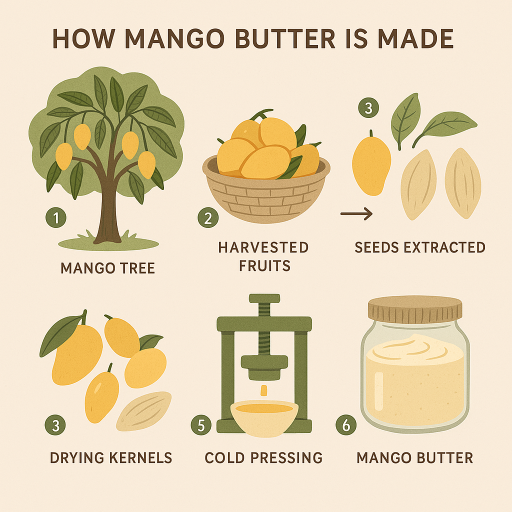
If you’re a fan of natural skincare or DIY beauty products, chances are you’ve come across mango butter. But what exactly is it, and how does a tropical fruit turn into a rich, creamy butter? Let’s explore the journey of mango butter—from seed to skin.
🌿 What is Mango Butter?
Mango butter is a soft, nourishing fat extracted from the seed kernel of the mango fruit (Mangifera indica). Unlike the juicy pulp we eat, the butter comes from the large seed inside the fruit. It’s prized for its moisturizing, soothing, and antioxidant properties, making it a favorite in skincare and haircare products.
🌳 From Seedling to Fruit: The Mango Tree’s Journey
Before we get to the butter, it all starts with the mango tree:
- Seed-grown trees take about 5 to 8 years to bear fruit.
- Grafted trees, commonly used in agriculture, can produce fruit in 3 to 5 years.
- Mango trees can live for over 100 years, producing fruit seasonally.
🥭 Harvesting and Extracting the Kernel
Once the mangoes are harvested, the process of making mango butter begins:
- Fruit Processing: After the pulp is removed for food products, the seeds are collected.
- Kernel Extraction: The hard outer shell of the seed is cracked open to reveal the inner kernel.
- Drying: These kernels are dried—either in the sun or using machines—to reduce moisture.
🧈 How is Mango Butter Made?
There are two main methods for extracting mango butter:
1. Cold Pressed (Natural Method)
- The dried kernels are crushed into a paste.
- The paste is cold-pressed to extract the butter.
- The butter is filtered and packaged, retaining most of its nutrients and natural scent.
2. Solvent Extraction (Industrial Method)
- Kernels are ground and treated with a food-safe solvent (like hexane).
- The solvent is evaporated, leaving behind the fat.
- The butter is often refined, bleached, and deodorized (RBD) for commercial use.
✨ What Does Mango Butter Look and Feel Like?
- Color: Pale yellow to off-white
- Texture: Solid at room temperature, but melts easily on skin
- Scent: Mild, sometimes slightly nutty or odorless if refined
💧 Benefits and Uses
Mango butter is rich in fatty acids, vitamins A and E, and antioxidants. It’s commonly used in:
- Skincare: Lotions, body butters, lip balms
- Haircare: Deep conditioners, styling creams
- Cosmetics: Soaps, creams, and balms
- Food (occasionally): In some regions, it’s used as a cooking fat
🌎 A Sustainable Choice
Mango butter is often made using byproducts of the fruit industry, making it a sustainable and eco-friendly ingredient. It’s a great way to reduce waste while nourishing your skin naturally.
